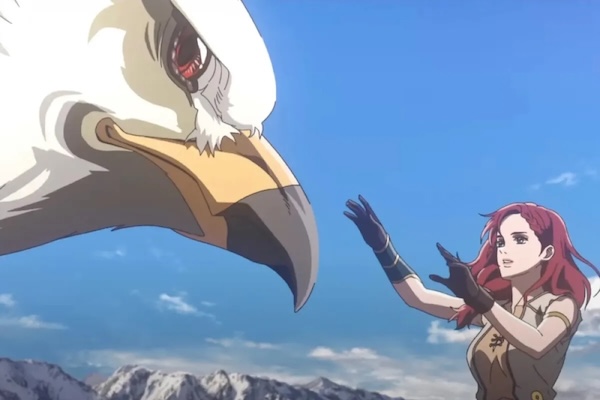Film Review: “The Lord of the Rings: The War of the Rohirrim” — Troll Poopies
By Michael Marano
Ya gotta understand — corporate assholes are like Sauron’s boss, Morgoth. They are incapable of creation. They can only appropriate and warp, like how Morgoth appropriated and warped Elves to create Orcs.
The Lord of the Rings: The War of the Rohirrim, directed by Kenji Kamiyama. Screening at Alamo Drafthouse Cinema Boston, AMC Boston Common 19, Apple Cinemas Cambridge.

A scene from The Lord of the Rings: The War of the Rohirrim. Photo: Warner Bros. Animation
I wish I could tell you that the new animated movie The Lord of the Rings: The War of the Rohirrim is the apotheosis of the corporatization and debasement of Tolkien’s work, its final transformation into something the writer would have despised. But it’s not the apotheosis/nadir. More troll droppings like this are on the way.
Ya gotta understand — corporate assholes are like Sauron’s boss, Morgoth. They are incapable of creation. They can only appropriate and warp, like how Morgoth appropriated and warped Elves to create Orcs.
Much as I admire and love Peter Jackson’s film trilogy of Lord of the Rings, there’s no denying that its more than 5 billion dollars in grosses has awakened something Balrog-y and ugly among our corporate masters. What could be more the antithesis of tree-hugger Tolkien’s ecological obsessions than a gas-guzzling SUV? And yet, in 2002, KIA used free Fellowship of the Ring DVDs as incentives to get people to test drive their Mordor-mobile Sorentos, which only got 13 miles to the gallon.
Jackson’s first trilogy, love ’em or hate ’em, had artistry. What drove those movies was the desire to make good on a challenge: to film the most popular books of the 20th century, presumed by many to be unfilmable. But, after mainlining an infusion of 5 billion smackers, Tolkien became a franchise. A commodity. A franchise is, by definition, a machine made to make money, not art. As, per Tolkien, “the machine” of the modern world is a development of human potential gone wrong, perverted through coercion and domination. As the author wrote to his son Christopher in 1944:
There is the tragedy and despair of all machinery [of the modern world] laid bare. Unlike art which is content to create a new secondary world in the mind, it attempts to actualize desire, and so to create power in this World; and that cannot really be done with any real satisfaction.
That’s the hitch, isn’t it?
Without “any real satisfaction?”
Art exists to create that “new secondary world in the mind” and products squeezed out by the robotics of a franchise exist to get you to buy the next installment of the product. It takes the average adult six hours to read The Hobbit. Peter Jackson could have made a bang-up version of The Hobbit three hours long. But the worldly demands of a franchise, not the artistry of storytelling, compelled Jackson to create a bloated, dull, and unwatchable nine-hour extended version of The Hobbit.
As for the Amazon TV show The Rings of Power… aside from the show being utter crap… wasn’t the whole point of Lord of the Rings about preventing the Shire-folk from being enslaved in “dark Satanic Mills”? But Amazon, in the name of profit, routinely exploits and endangers labor here in the US and abroad. The shitty Rings of Power show is paid for via the very thing Tolkien didn’t want to befall the Shire. As for Tolkien’s disdain for the “Machine” of modernity, here is what his son John said in 1996:
[Tolkien] used to sort of say, ‘You only move the slavery out of sight [with the advent of Modernity], so it’s much more effective because no one knows what’s going on. So you put them [the exploited laborers] in the factories where you can’t see them.’
Franchise management, as opposed to storytelling, can’t produce genuine artistry. Because it is so thoroughly corporatized, a franchise is built out of factory-like labor; it can only generate capital, not create an imaginative dialogue with a “secondary world”.
The War of the Rohirrim takes place 200 years before Lord of the Rings, and tells the story of King Helm Hammerhand of Rohan. Truthfully, the saga of Helm and the end of his reign, two and half pages in the Appendices of Lord of the Rings, could have made a banger of a movie. And focusing the tale on Helm’s daughter Hera (unnamed by Tolkien’s Legendarium) is a great idea. But the movie has five credited writers. This is an assembly-line job, a gear in the machine of franchise management. The movie can’t provide any emotional satisfaction because it’s not crafted to satisfy lovers of story, but shareholders.
While there are some breathtaking images in The War of the Rohirrim, the film is a dead product. Director Kenji Kamiyama is no slouch. The framing, sense of scale, and composition in some shots can be stunning. But the blending of anime aesthetics and Tolkien’s themes feels very forced. At first, I sort of welcomed that roughness — it seemed to be something new. And then… the sloppy plotting and cliches kicks in. Eventually, the movie just counts on the goodwill and Pavlovian cues from Jackson’s trilogy from 20 years ago to carry it through its 2-hour and 15-minute runtime. Example? The soundtrack blows warg nuts, except when it steals from Howard Shore’s score from The Two Towers. A lot of the designs blow, including Rohirrim wearing spotlessly white riding outfits that look like Space Cruiser Yamato uniforms through the mud, except when the design team steals from… yeah… The Two Towers.
The lapses in logic made me clench my jaw until I thought my molars would crack. An expert in heraldry fails to recognize a sigil because the plot necessitates it. A battle-hardened warrior standing at the ready for months forgets there’s such a thing as… scouts. Plus other idiocies too numerous to name.
And there’s the fact that the narrative centerpiece of The War of the Rohirrim is a siege. Now, there have been some bitchin’ movies about sieges. Rio Bravo. The Seven Samurai. Zulu. Even Night of the Living Dead. But once the movie retreats behind those walls, the story crawls into a corner and dies. It doesn’t know what else to do with itself.
Sort of like how the current stewards of Tolkien’s legacy don’t know what to do with that legacy. Except to keep milking it with product like this, soulless as a barrow-wight. Meanwhile, more seasons of Rings of Power are to come and, Gandalf Save Us, a feature covering The Hunt for Gollum and another Lord of the Rings movie after that.
Novelist, writing instructor, book doctor, Dungeons & Dragons nerd and personal trainer Michael Marano (www.BluePencilMike.com) used to read Lord of the Rings once a year.
Tagged: Kenji Kamiyama, Lord of the Rings, Peter Jackson, animation
